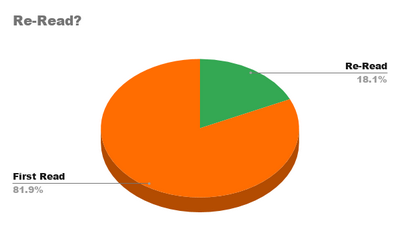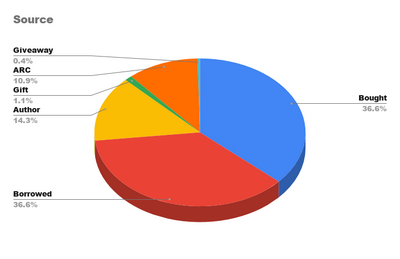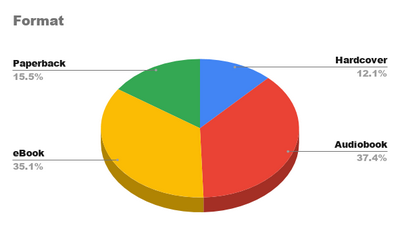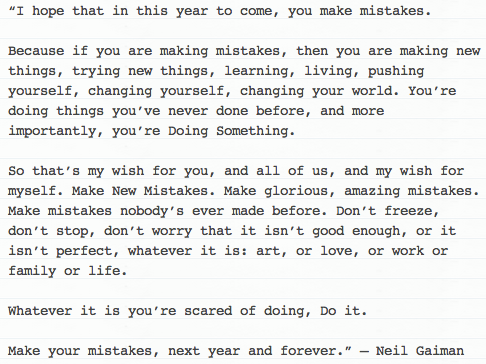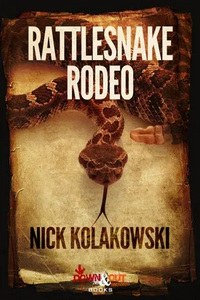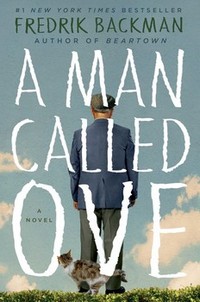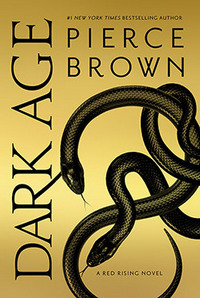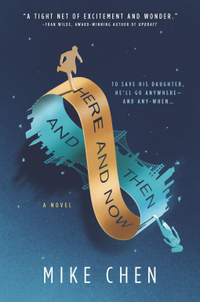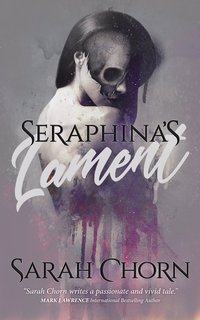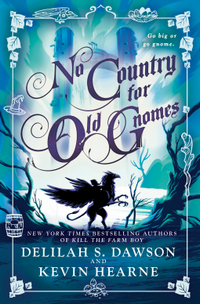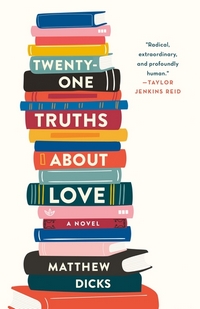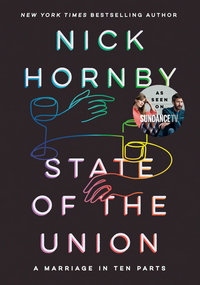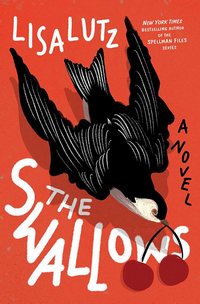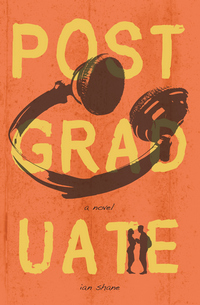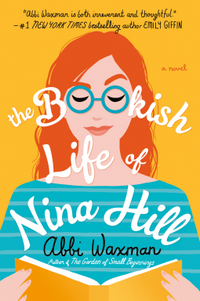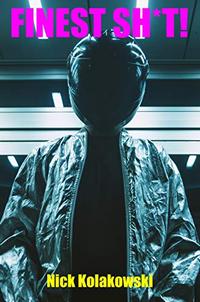|


In 2018, I read my first book by Nick Kolokowski, Boise Longpig Hunting Club, which is pretty much everything you think it is from the title. In the two years and change since then, I’ve read five other books by Kolokowski—well, six now. That alone should be an indication of what I think about his stuff.
What’s Rattlesnake Rodeo About?
This is the sequel to Boise Longpig Hunting Club, taking up minutes after it. Spoilerly talk about BLHC—bounty hunter, Jake; his sister, Frankie (a gun smuggler); and ex-wife/fiancé, Janine (who has nothing to do with criminals); are kidnapped by a group of super-wealthy people, and set loose in an Idaho forest while they’re being hunted. Jake and Frankie are a lot more resourceful than anyone expected—and Janine has depth that no one expected—and they end up killing all the hunters.
We rejoin them in this book headed back to Boise. They have a number of emotions and thoughts running through their minds at this time—as they should—the most prominent of them is: how are we going to get away with this? There’s no way that they didn’t leave all sorts of DNA, fingerprints and other sorts of evidence behind that’ll make forensic techs happy. And there will be scores of techs, investigators, agents and what have you at the crime scene—very rich, very important people died up there and someone is going to have to pay for that. Oh, and Frankie wants fries. You work up an appetite fighting for your life.
Karen
They quickly learn about one person who not only has links to the Longpig Hunters, evidence about Jake and Frankie’s involvement, and a reputation to make people quake in their boots. Like Prince, Madonna, or Hawk (to bring it back to crime fiction), she’s known by one name: Karen.
Quick aside: I wonder if in early drafts, she was called something like Margo or Helen, but given, well, all of 2020, Kolakowski decided to go back and change it. Or did he have enough foresight months ago to go with that?
Back to the book: Karen offers them a deal, they do one incredibly horrible task for her, or she ruins the lives and reputations of Jake, Frankie, and Janine. They have no choice…they have to find an Option C.
Gunfights, treachery, and (obviously) rattlesnakes ensue.
Frankie and Her Troops
In almost every novel I’d normally read, Frankie and her employees would be the targets of the protagonist, not their ally. But I’ve gotta say, for a bunch of gun-running criminals, benefiting from the miseries of others (and being a means to innocents being killed at the hands of their customers), they’re a lot of fun. There’s a fun sense of camaraderie and some good banter among them. They’re a pretty effective squad, too. Kolakowski could write a pretty entertaining series featuring these guys. And not just because they’re led by a man who always wears a rubber gorilla mask.
Which is fitting, considering how cool their boss is. Spenser has Hawk, Kenzie and Gennaro have Bubba, Elvis Cole has Joe Pike, Walt Longmire has Henry Standing Bear, Joe Pickett has Nate Romanowski, Sunny Randall has Spike, and Jake has Frankie. The “not-bound by the same laws and ethics that the series protagonist is” so that the protagonist can keep his/her nose clean and still get the job done. They’ll cut the corners, they’ll take and make the shots that no one else will, they’ll be the ones to use lethal force when their friend just can’t bring themselves to do it—and they won’t feel guilt (at least not enough to interfere with their ability to get things done).
Frankie is, as far as I know, the only female lethal sidekick, in crime fiction. Through grit, determination, skill, and panache—Frankie is what ultimately keeps her brother and sister-in-law breathing. It’s just fun to see a female in this role, particularly one that fits. I could never see Sunny Randall go toe-to-toe with some of the dudes she needs to without Spike (or Jesse, or Richie, or Richie’s family)—but I can see Frankie (like Lori Anderson or Charlie Fox) do it without blinking.
The Setting
I’ve talked a little about this in the other book, but it’s fun for me to see the region I’ve lived my whole life in depicted so well in these pages. I enjoy anyone finding a way to bring a crime novel to life outside of Boston, NYC, New Jersey, Chicago, Miami or LA—Elmore Leonard, Jason Miller, Craig Johnson, C. J. Box, Darynda Jones, and G. M. Ford have/continue to do a good job of that, but there needs to be more*. Kolakowski brings my corner of the world into that fold (Jayne Faith did it in Urban Fantasy, and Wesley Chu set a Tao book near where the climax of this novel took place). It’s nice not having to use my imagination much when picturing a scene, at the same time—if I’d never been anywhere near this place, Kolakowski depicts it well enough that someone from Michigan, Mississippi, or New Mexico would have no problem seeing what he’s going for.
* I don’t pretend that’s an exhaustive list, still feel free to add others I should get to know.
So, what did I think about Rattlesnake Rodeo?
You could feel the dread coming off of Jake and Frankie as they thought about the police and (probably) feds coming for them after surviving the last novel, you could feel their hatred (for Karen) and revulsion for their task for her, and you could sense the chaos, smell the smoke, and taste the air from the big scenes at the end of the novel. There are significant portions of this novel you experience as much as you read. You’ve gotta love that.
There was one death that totally caught me unprepared and left me stunned. The violence felt a little more grounded than the genre demands, but Kolakowski knows when to loosen the reins and let things go a little over the top. Which is just fun.
At the same time, there’s a great sense of enjoyment to this novel—to the characters, what they do, and how they go about it. It’s the kind of action novel that gets your fists pumping as much as anything else.
Just the fact that the novel starts with the trio worried about all the evidence they left behind made this a winner—how many characters in novels worry about that sort of thing? Add in the characters—from the oddity of Monkey Man, to the implausibly competent Frankie, to the quiet strength of Janine, to the terror that is Karen—and the great balance of tones, and you’ll see why Kolakowski is my favorite US indie Crime Novelist.
I strongly recommend Rattlesnake Rodeo, whether or not you read BLHC first, it’s a fun ride.
Disclaimer: I received this eARC from the author in exchange for this post and my honest opinion, I appreciate the opportunity.


Like last year, while trying to come up with a Top 10 this year, I ran into a small problem (at least for me). Crime/Thriller/Mystery novels made up approximately half of the novels I read this year and therefore dominated the candidates. So, I decided to split them into 2 lists—one for Crime Fiction and one for Everything Else. Not the catchiest title, I grant you, but you get what you pay for.
These are my favorites, the things that have stuck with me in a way others haven’t—not necessarily the best things I read (but there’s a good deal of overlap, too). But these ten entertained me or grabbed me emotionally unlike the rest.
Anyway…I say this every year, but . . . Most people do this in mid-December or so, but a few years ago (before this blog), the best novel I read that year was also the last. Ever since then, I just can’t pull the trigger until January 1. Also, none of these are re-reads, I can’t have everyone losing to books that I’ve loved for 2 decades that I happened to have read this year.
Enough blather…on to the list.
(in alphabetical order by author)
by Fredrik Backman, Henning Koch (Translator)
My original post
I’ve been telling myself every year since 2016 that I was going to read all of Backman’s novels after falling in love with his My Grandmother Asked Me to Tell You She’s Sorry. The closest I got was last year when I read his first novel, A Man Called Ove (and nothing else). It’s enough to make me resolve to read more of them, and soon. The story of an old, grumpy widower befriending (against his will, I should stress) a pretty diverse group of his neighbors. It’s more than that thumbnail, but I’m trying to be brief. The story was fairly predictable, but there’s something about the way that Backman put it together that makes it perfect. And even the things you see coming will get you misty (if not elicit actual tears).


by Pierce Brown
My original post
When I started reading this, I was figuring that Pierce Brown’s Red Rising Saga was on the downward trend. Boy, was I wrong. Dark Age showed me that time after time after time after time . . . Entertaining, occasionally amusing, stress-inducing, heart-wrenching, flat-out captivating. It was brutal and beautiful and I can’t believe I doubted Brown for a minute.


by Mike Chen
My original post
One of the best Time Travel stories I’ve ever read, but it’s so much more—it’s about fatherhood, it’s about love, it’s about friendship. Heart, soul, laughs, and heartbreak—I don’t know what else you want out of a time travel story. Or any story, really. Characters you can like (even when they do things you don’t like), characters you want to know better, characters you want to hang out with after the story (or during it, just not during the major plot point times), and a great plotline.


by Sarah Chorn
My original post
Chorn’s prose is as beautiful as her world is dark and disturbing. This Fantasy depicts a culture’s collapse and promises the rebirth of a world, but getting there is rough. Time and time again while reading this book, I was struck by how unique, how unusual this experience was. As different as fantasy novels tend to be from each other, by and large, most of them feel the same as you read it (I guess that’s true of all genres). But I kept coming back to how unusual this feels compared to other fantasies I’ve read. The experience of reading Seraphina’s Lament isn’t something I’ll forget any time soon.


by Delilah S. Dawson and Kevin Hearne
My original post
Having established their off-kilter world, strong voice, and approach to the stories of Pell, Dawson and Hearne have come back to play in it. The result is superior in every way that I can think of. I lost track of how many times I said to myself while reading something along the lines of, “how did they improve things this much?” These books are noted (as I’ve focused on) for their comedy—but they’re about a lot more than comedy. The battle scenes are exciting. The emotional themes and reactions are genuine and unforced. And tragedy hits hard. It’s easy to forget in the middle of inspiring moments or humorous aftermaths of battle that these kind of novels involve death and other forms of loss—and when you do forget, you are open to getting your heart punched.
(but mostly you laugh)


by Matthew Dicks
My original post
It’s an unconventionally told story about a man figuring out how to be a businessman, husband, and father in some extreme circumstances. The lists are the star of the show, but it’s the heart behind them that made this novel a winner.


by Nick Hornby
My original post
This series of brief conversations held between a married couple just before their marriage counseling sessions. At the end of the day, this is exactly what you want from a Nick Hornby book (except the length—I wanted more, always): funny, heartfelt, charming, (seemingly) effortless, and makes you feel a wide range of emotions without feeling manipulated. I loved it, I think you will, too.


by Lisa Lutz
My original post
This is not my favorite Lutz novel, but I think it’s her best. It has a very different kind of humor than we got in The Spellman Files, but it’s probably as funny as Lutz has been since the third book in that series—but deadly serious, nonetheless. Lutz puts on a clinic for naturally shifting tone and using that to highlight the important stories she’s telling. From the funny and dark beginning to the perfect and bitingly ominous last three paragraphs The Swallows is a winner. Timely and appropriate, but using tropes and themes that are familiar to readers everywhere, Lutz has given us a thrilling novel for our day—provocative, entertaining, and haunting. This is one of those books that probably hews really close to things that could or have happened and you’re better off hoping are fictional.


by Ian Shane
My original post
This has the general feel of Hornby, Tropper, Norman, Weiner, Russo (in his lighter moments), Perrotta, etc. The writing is engaging, catchy, welcoming. Shane writes in a way that you like reading his prose—no matter what’s happening. It’s pleasant and charming with moments of not-quite-brilliance, but close enough. Shane’s style doesn’t draw attention to itself, if anything, it deflects it. It’s not flashy, but it’s good. The protagonist feels like an old friend, the world is comfortable and relaxing to be in (I should stress about 87.3 percent of what I know about radio comes from this book, so it’s not that). This belongs in the same discussion with the best of Hornby and Tropper—it’s exactly the kind of thing I hope to read when I’m not reading a “genre” novel (I hate that phrase, but I don’t know what else to put there).


by Abbi Waxman
My original post
This is a novel filled with readers, book nerds and the people who like (and love) them. There’s a nice story of a woman learning to overcome her anxieties to embrace new people in her life and heart with a sweet love story tagged on to it. Your mileage may vary, obviously, but I can’t imagine a world where anyone who reads my blog not enjoying this novel and protagonist. It’s charming, witty, funny, touching, heart-string-tugging, and generally entertaining. This is the only book on this particular list that I know would’ve found a place on a top ten that included Crime Novels as well, few things made me as happy in 2019 as this book did for a few hours (and in fleeting moments since then as I reflect on it).


Books that almost made the list (links to my original posts): Not Famous by Matthew Hanover, Circle of the Moon by Faith Hunter, Maxine Unleashes Doomsday by Nick Kolakowski, In an Absent Dream by Seanan McGuire, The Rosie Result by Graeme Simsion, and Lingering by Melissa Simonson

Man…this is the third time I’ve got to pick Nick Kolakowski’s brain (the first and the second, for you completists). I can’t believe he keeps coming back for more — but when I get great answers like these, I’ve gotta keep asking, you know? Do read the others if you’re wanting to learn more about him in general — I stuck to Maxine Unleashes Doomsday (I posted about it earlier today, in case you missed that) this time.
Hope you enjoy!
| Did you set out to write Science Fiction or is that something that came about as you started the project? |
|
I’ve always wanted to write a dystopian novel, but all my early attempts were ignoble failures; they were Diet Cormac McCarthy, pastiches of “The Road” that were just retreads of what everyone else was trying to do. It’s only when I mashed the concept onto a noir framework that it started to work for me—a heist novel was the grounding that I needed, even if the target of that heist, in this post-apocalyptic context, is really, really weird. |
|
| What were some of the new challenges (and/or freedoms) compared to your earlier works given this setting/genre? |
|
I’ve never written a book that covers the whole scope of someone’s life. Any novel comes with its share of continuity challenges; even if the timeframe is really short (i.e., a few hours or days), you need to keep all of your pieces and characters aligned and consistent. But keeping the details of a character’s life aligned across decades can prove much more difficult—did this happen to her left or right arm when she was a teenager, etc.
In terms of freedoms, though, you can create an incredible character arc if you have that kind of super-expansive timeframe to play with. There’s a real poignancy to tracing someone’s life from their teenagehood to the very end, especially if the country is radically changing around them at the same time. |
|
| What came first—the story or Maxine? Is that your typical approach, or does it vary from project to project? |
|
Maxine came first: I had a vision of a badass woman, bitter and chain-smoking but refusing to give up no matter what life threw at her. From there, I wanted a story that put her in worse and worse circumstances. What happens to someone who loses everything? What’s left?
In terms of actual writing, this book started in the middle. Then I wrote Maxine’s childhood and teenage-dom. Then I stalled for about a year because I couldn’t think of where to take her from there; it was only when I came up with the broader framework—of academics discussing her life and her impact on society—that I figured out where to take everything. |
|
| In this book, Preacher reminded me a lot of Main Bad Guy’s Walker—but a very different take on the character type. Is 2019 your Year of the Aging Badass, or is that just a coincidence? I’m having a hard time not asking a spoiler-laden question about him, so let me take the easy way out – what would a prospective reader want to know about Maxine’s very disfunctional paternal figure? |
|
That was a coincidence, but now that you mention it… yeah, Preacher and Walker are brothers of a type! I didn’t mean it that way; Preacher made his first appearance in my head circa 2014, while Walker emerged around 2017-18, when I was writing “Main Bad Guy.”
Not to spoil too much, but Preacher isn’t the badass that Maxine thinks. He’s ultra-tough, and he deserves his fearsome reputation in the ruined part of the world where Maxine and her family lives. But his weaknesses—and frankly, his lies—eventually force Maxine to step up. The thing about badasses like Preacher and Walker, they can serve as crutches for your main character; at some point, you need to neuter them or take them away if your protagonist is truly going to move on and grow. |
|
| Are you far enough into your next book to talk about it – are you sticking with SF, going back to Crime Fiction, or trying your hand at something like Wizards? |
|
Haha! Noir-ish wizards would be pretty cool, although I’m sure someone has already covered that arena already. Up next is actually the sequel to “Boise Longpig Hunting Club,” so it’s back to crime fiction (and Idaho!). The as-yet-untitled sequel is actually giving me a bit of trouble, because I’m trying to ratchet up the tension as tightly as possible on Jake and Frankie, my two main characters (and siblings). They survived some insane crap in the first book, so I have to figure out a way to make things even crazier. |
|
| Thanks for your time—and thanks for introducing me to Maxine |
|
Thank you! I love her. I hope readers will, too. |
|

This is one of those books that I’m uber-excited about, yet I don’t think I do a good enough job at explaining why I am. It’s just good.
—
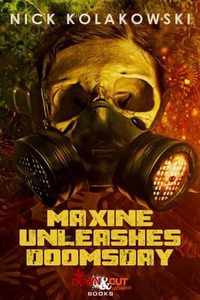 |
by Nick Kolakowski
eARC, 274 pg.
Down & Out Books, 2019
Read: October 29-31, 2019 |

“You know the trick to surviving? The one thing you got to do?”
“What’s that?” Maxine asked.
“You got to treat every day like an adventure. Like it’s fun, or a challenge, even when everything’s crappy. Especially when it’s crappy. Because otherwise, it’s all going to crush you.”
“I feel like I spent my whole life being crushed.”
“Well, that’s your fault. A normal job, trying to live a normal life, it’s just inviting people to stomp you. And they do.”
“Yeah.”
“But at least in my line of work, sometimes you get to stomp back…”
In case the author’s name looks familiar to you, yeah, you’ve seen me use it a few times this year—3 novellas, 1 short fiction collection, and now this novel, Maxine Unleashes Doomsday. It occurs to me now, that he was the first author I read this year, and he did a pretty good job setting the tone for 2019’s reading. This book is his first step out of Crime Fiction and into Science Fiction—dystopian SF, to be precise (that really should be obvious to anyone familiar with him, I don’t think he’s got a utopian novel in him).
That said, there’s enough of a Crime Fiction flavor to this SF novel, that fans of either genre will have enough of their drug of choice to be satisfied.
This is set in the near-future, at various points along the fall of the US/Western Civilization. While there are plenty of other characters to keep an eye on, our focus throughout is on Maxine. After a rocky start to life with a drug-addicted mother, and an unsuccessful academic career (although she tried for a little bit), she tries to follow her uncle’s example and become a criminal. She has some success in that, but a large failure resulted in life-threatening injuries to a friend and the loss of one of her arms. Following that, she tries to live a non-criminal life, she gets a job, settles down with a guy and has a kid. But her heart’s not in it, and she ends up dabbling in thievery. At some point, she abandons that life and sets her eyes on a criminal career.
Maxine is one of my favorite characters this year—she’s flawed (not as flawed as she thinks), she’s a fighter (not as good as she thinks), self-destructive, optimistic, and driven. She takes a lot of (metaphorical and literal) punches, and while she may not get up right away after them, she doesn’t stop moving forward. Ever. I love reading characters like that.
Her uncle, who goes by Preacher, is one of the most significant criminals in the New York area—and has some cops dedicated to taking him down, and any number of civilians supporting him. Off and on throughout her childhood, Preacher tried to get Maxine’s mother to leave her addictions behind to provide for and care for her kids. Between his power and influence on the one hand, and being just about the only adult to look out for her and her brother, it’s no wonder that Maxine will want to be part of his life. Readers of Kolakowski’s Main Bad Guy will enjoy playing a compare/contrast game with Preacher and Walker.
There are a number of other characters that greatly influence Maxine’s life and desires, but none so much as her uncle. And to get into them would just push this post beyond the length I want (and would end up spoiling stuff to really talk about).
By and large, this is the story of Maxine’s journey from a struggling public school student to being a wanted criminal (and beyond). But that’s not everything that’s going on. For the first chapter, you get the impression you’ll be reading a book about rival groups fighting for supplies in mid-apocalyptic New York. But then you’ll realize that’s not it at all, it’s a story about how Maxine became the tenacious gun-fighter and would-be criminal mastermind that she is. Eventually you discover that yeah, both of those are true, but Kolakowski’s really writing a different story—and boy howdy, you feel pretty clever when you suss it out, and it’s such a brilliant way of telling this story that you don’t mind being wrong about what the book is trying to accomplish. But even then, you won’t really understand everything until the last line of the book (I’m not sure I actually pumped my fist when I read it, but I probably thought about it pretty hard).
Yes, it’s a pretty violent book (this too, should really be obvious to anyone familiar with Kolakowsi), but most of the truly horrible stuff happens “off-screen,” making it a lot easier to take. The prose moves quickly and assuredly, the writing is sone with a strong sense of style and savoir faire. Frankly, it’s too lively and enjoyable to keep the most readers who aren’t into gunfights, etc. from being turned off by the violence.
It’s a well-realized dystopia, one that’s easier to imagine happening than say, Panem. Kolakowski does a wonderful job of littering this book with little details that tell you so much about the world his characters live in and entertain the reader. Hitting both of those notes regularly is a difficult task. For example:
“Someday I want to go to California,” Michelle told Maxine. “Did you know it used to be a state?”
and
This far north, the concept of local government grew teeth and claws. If you stuck to the highway, you would cross into territory controlled largely by the New York Giants, which had expanded beyond its origin as one of the nation’s most consistently mediocre sports teams to control a big swath of towns northeast of Buffalo.
One of the conceits of the book is that the material is a result of an academic study about Maxine. It’s one of the best moves that Kolakowski makes in this book (and it’s full of great moves). Don’t skim over these notes, you’ll be rewarded for your attention.
Oh, I should warn you: This book might put you off popcorn for a while. I’m just saying…
Rob Hart wrote one of the endorsements for this: “Take one of Richard Stark’s Parker novels and throw it in the blender with DVDs of Mad Max and The Warriors. Guess what? You just broke your blender. Find solace in this book, which is what you should have done in the first place.” I repeat that for a couple of reasons—1. I love the last two sentences. 2. He’s right, and says everything in 4 sentences that I tried to above. You should listen to one of us. Kolakowski has outdone himself with this one, it was a pleasure from end to end. You really need to read it.
Disclaimer: I was provided a copy of this novel by the author in exchange for this post and my honest opinion. My opinions are my own, and weren’t influenced by this.

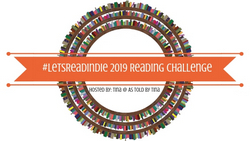

I’m going to be kicking off my involvement in #IndieCrimeCrawl with the latest from Nick Kolakowski. About a year ago, he emailed me to take a peek at his novel Boise Longpig Hunting Club, a fast, energetic, visceral read. Then came his Love & Bullets Hookup Trilogy — which was as entertaining as you could want. Now it’s time for his new short fiction collection, which I pre-ordered the instant I heard about it. One of the best things about Indie Crime Fiction is the depth of strong voices with perspectives you don’t find every day. Nick Kolakowski is a prime example of this. Check out all of his work, you’ll be in for a treat.
—
by Nick Kolakowski
Series: Loose Rounds, Book 2Kindle Edition, 202 pg.
Final Round Press, 2019
Read: June 14 – July 3, 2019

| |
With a feral yelp, Raoul worked the dial until he landed on a station thundering drums and guitar, a solid backbeat for Luis and Jesus slicing and shoveling mounds of peppers and onions and pig. The music blasted the asphalt amphitheater of the parking lot, signaling that the truck was officially open for business.
The first customers drifted toward them. Give me your hungry, your nearly broke, your masses yearning for lunchtime deliciousness, Jesus thought as he wiped his hands on his apron and prepared to meet the first of the lunch rush. And I’ll give you two tacos for three dollars. |
That’s from “Taco Truck,” one of the ten short stories that appear with a novella in Nick Kolakowski’s latest collection, Finest Sh*t!: Deviant Stories. There are tales of revenge, heroism, thwarted revenge, and people driven to extremes no one should be driven to — even some SF. Essentially, like with the best of Crime Fiction (no matter when it’s set) we have people in desperate situations (sometimes of their own making, sometimes out of their control) doing what they needed to.
As with every short story collection, there are some of these short stories that really, really worked for me, and others that didn’t do much for me at all — that’s just how it goes. But even the stories that I didn’t appreciate had that Kolakowski quality that I’ve really come to enjoy.
The novella, The Farm takes up about half of the book. It begins in 1931 and ends in 2008, following one farming family through the generations. This family goes through wars, violent crime, financial hardship, betrayal — and more than a few of the more positive parts of life, too. There’s some poetry, too. I guess that qualifies as one of the more positive aspects, but I’m not always sure. In the end, I really liked this novella — but it took some effort to get into it. That’s probably on me. Kolakowski fits a novel’s worth of a family saga into this roughly 100 pages — which is quite a feat. There’s part of me that would like to see it developed into a 350-400 page novel to flush out some of the details, but I think he’s right to keep it brief. It alone is well worth grabbing the collection.
This collection covers all sorts of tones, topics and perspectives. As I’ve come to expect from Kolakowski, I wouldn’t have predicted anything that I found in these pages. My rating may be on the low side, but that’s just because I couldn’t really sink my teeth into anything — I typically rate short story collections low. But there’s gold in here — a little dross (but what I think is dross will probably appeal to others). If you’re not familiar with Kolakowski, this is a great way to introduce yourself to one of the strongest voices in Crime Fiction today. If you are familiar with him, you don’t need me to tell you how good these stories can be.
—–

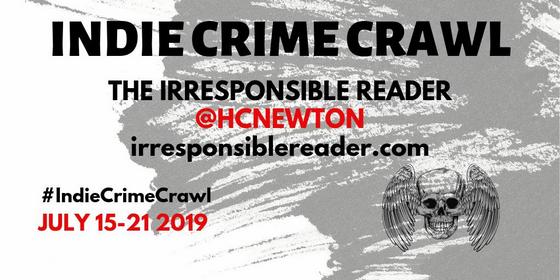
Nick Kolakowski’s back for another round of questions (feel free to check out the last round while you’re here), to commemorate the kick-off to Main Bad Guy (which I just posted about), the conclusion to his trilogy of Love & Bullets Hookups.
Since we covered a lot of the basics last year, I dove deeper into this trilogy than I usually do. I hope you enjoy this as much as I did and that it spurs you to check these books out.
| Was A Brutal Bunch of Heartbroken Saps always supposed to kick-off a series, or did that idea come during/after writing it? It’s not your everyday way to start a trilogy about a couple, why this approach? |
|
“A Brutal Bunch of Heartbroken Saps” was originally going to be a standalone. After it was finished (but before publication), I found myself still jotting down bits of Fiona and Bill—scraps of dialogue, the outline of an action scene, etc. So I realized I wasn’t done with either of them, at least on a subconscious level. But where to take the story next? I didn’t want it to become an open-ended series, so I needed to figure out a way to climax it, to resolve all the dangling plot threads I began weaving in “Brutal Bunch.” And that meant taking Fiona and Bill back to New York City, where everything began. |
|
| Why the Elvis suit? It was absolutely a great idea — but I’ve spent weeks coming back to this question, why did you pick that? |
|
The suit is iconic and ludicrous, but it’s also (to me, at least) a symbol of courage. Can you imagine what it took for Elvis to suit up in that thing every night, step in front of hundreds of people, and belt out something like “Suspicious Minds”? In any case, the suit has so much power, it felt like the perfect thing for a character who’s emotionally wounded and more than a little insane to slip into—he draws enough from it to keep going.
I (very) briefly considered making it a John Wayne thing, and having him put on a vest and a cowboy hat, but that didn’t really work—as a costume, it didn’t pack the same ludicrous punch as a sparkly Elvis jumpsuit. |
|
| Two things in particular made me realize that Main Bad Guy was going to be the best of the trilogy early on — Fiona’s “origin story” and Walker. I love it when we get a mysterious figure like him and are given juuuuuuust enough information to buy into the character, but are left with a billion questions. Where did Walker come from, and have you considered doing more with him? |
|
“Aging Badass” is a noir/thriller trope that I particularly love—the older guy who’s seen and done too much to get particularly bothered over anything that happens, even if what’s happening is really ludicrous and bloody and crazy (think James Caan in “Way of the Gun,” or Jonathan Banks in “Better Call Saul”). I’ve wanted to do my own variation on that type of character for years, but I needed him to be a bit more flawed and human. Walker is a badass but his skills are rusty; he’s a tactical genius but he has a certain impulsiveness—mirrored by his daughter—that leads him to do things that get him into trouble.
I do want to do more with Walker in the future. Writing him was an enormous amount of fun, especially the scene in “Main Bad Guy” where he walks into his favorite bar and finds it’s been converted into a hipster hellhole, complete with paintings of pugs on the walls. Maybe I’ll do a novella where he comes back and wrecks it. |
|
| There’s this great thread running throughout the trilogy, chronicling the rise and evolution of The Rockaway Mob. Some authors would devote a novel or three to this saga, you make it something that can be overlooked. How intentional was that, and what was your reasoning? |
|
It was pretty intentional. I wanted the books to be as fast as possible, and as much as I loved (briefly) tracing out the rise and fall of this very weird gang (and its very weird leaders), I felt it would distract a bit from the core of the story, which is the incredible flight of Fiona and Bill. |
|
| Is there a genre that you particularly enjoy reading, but could never write? Or are you primarily a mystery/suspense/thriller reader? |
|
I’ve wanted to write a historical novel for years, but haven’t quite had the courage (or the time to plunge into extensive research). Maybe I’ll get to it—I just need to really commit myself to such a massive effort. |
|
| Thanks for your time — and thanks for these Hookups. |
|



